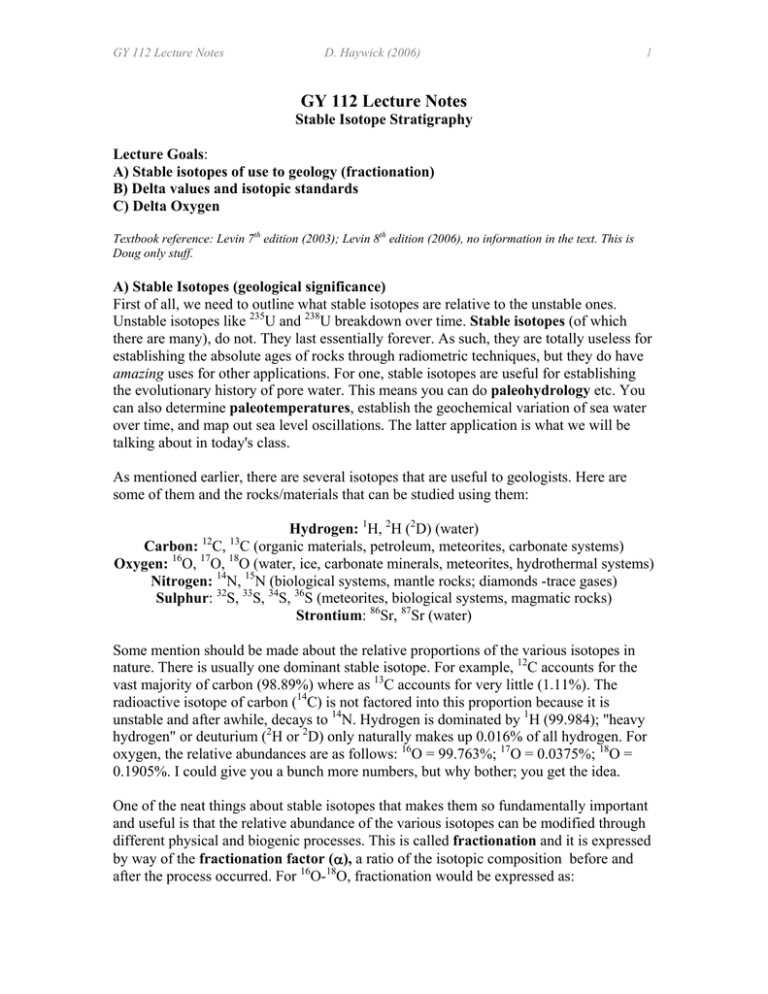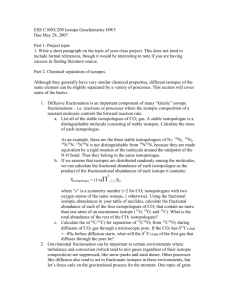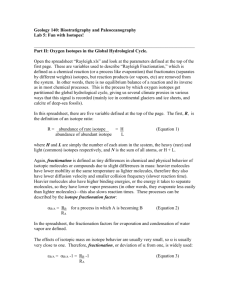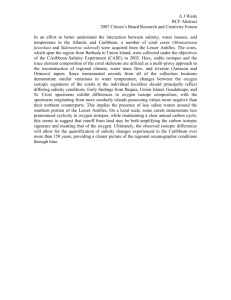GY 112 Lecture Notes
advertisement

GY 112 Lecture Notes D. Haywick (2006) 1 GY 112 Lecture Notes Stable Isotope Stratigraphy Lecture Goals: A) Stable isotopes of use to geology (fractionation) B) Delta values and isotopic standards C) Delta Oxygen Textbook reference: Levin 7th edition (2003); Levin 8th edition (2006), no information in the text. This is Doug only stuff. A) Stable Isotopes (geological significance) First of all, we need to outline what stable isotopes are relative to the unstable ones. Unstable isotopes like 235U and 238U breakdown over time. Stable isotopes (of which there are many), do not. They last essentially forever. As such, they are totally useless for establishing the absolute ages of rocks through radiometric techniques, but they do have amazing uses for other applications. For one, stable isotopes are useful for establishing the evolutionary history of pore water. This means you can do paleohydrology etc. You can also determine paleotemperatures, establish the geochemical variation of sea water over time, and map out sea level oscillations. The latter application is what we will be talking about in today's class. As mentioned earlier, there are several isotopes that are useful to geologists. Here are some of them and the rocks/materials that can be studied using them: Hydrogen: 1H, 2H (2D) (water) Carbon: C, C (organic materials, petroleum, meteorites, carbonate systems) Oxygen: 16O, 17O, 18O (water, ice, carbonate minerals, meteorites, hydrothermal systems) Nitrogen: 14N, 15N (biological systems, mantle rocks; diamonds -trace gases) Sulphur: 32S, 33S, 34S, 36S (meteorites, biological systems, magmatic rocks) Strontium: 86Sr, 87Sr (water) 12 13 Some mention should be made about the relative proportions of the various isotopes in nature. There is usually one dominant stable isotope. For example, 12C accounts for the vast majority of carbon (98.89%) where as 13C accounts for very little (1.11%). The radioactive isotope of carbon (14C) is not factored into this proportion because it is unstable and after awhile, decays to 14N. Hydrogen is dominated by 1H (99.984); "heavy hydrogen" or deuturium (2H or 2D) only naturally makes up 0.016% of all hydrogen. For oxygen, the relative abundances are as follows: 16O = 99.763%; 17O = 0.0375%; 18O = 0.1905%. I could give you a bunch more numbers, but why bother; you get the idea. One of the neat things about stable isotopes that makes them so fundamentally important and useful is that the relative abundance of the various isotopes can be modified through different physical and biogenic processes. This is called fractionation and it is expressed by way of the fractionation factor (α), a ratio of the isotopic composition before and after the process occurred. For 16O-18O, fractionation would be expressed as: GY 112 Lecture Notes D. Haywick (2006) 2 α = R1/R2 where R1 = 18O/16O of the product and R2 = 18O/16O of the starting material. This expression is almost too general to understand, so I'll give you a real example of how it works in a few minutes. First let's discuss why fractionation occurs at all. Simply put, some processes tend to concentrate one isotope over another. For examples, plants tend to preferentially fix 12C into their tissue as they grow. This means that they are isotopically lighter than the total available reservoir of carbon. For organic carbon, the fractionation factor would be expressed as: and would give you a value less than 1.0. Another process that involves fractionation is evaporation of seawater. Seawater mostly contains 16O and 16O evaporates easier than 18O does. If you were to measure the isotopic ratio of a cloud above the ocean (it is condensed water from the evaporation process), you would discover that fractionation had increased the relative proportion of 16O over 18O in the cloud. This has the most amazing connotations as you will see shortly. First, we need to define another Greek letter. Figure from Arthur, M.A. and others, 1983. Stable Isotopes in Sedimentary Geology. SEPM Short Course 10. GY 112 Lecture Notes D. Haywick (2006) 3 B) Delta Values The fractionation factor gives you an idea about how various processes shift stable isotopic ratios, but it doesn't give you the means to do quantitative work (there's that word quantitative again). As an example, consider the evaporation of water. When clouds form from evaporation and condensation of seawater, they become isotopically lighter than seawater. The same thing happens when clouds form from the evaporation and condensation of river water or lakes. These fresh bodies of water originally got onto land through evaporation, so they were isotopically lighter than seawater to begin with. Rainwater that is derived from the evaporation and condensation of water on land is much lighter (isotopically) that rain water derived from ocean water. Moreover, tropical seawater is often "heavier" than temperate seawater because it has undergone more evaporation which concentrates the heavier 18O isotope in the remaining seawater. Wow. This is getting confusing. The fractionation factor alone is insufficient to keep track of all this variation. Enter the "Delta Value". Its definition is pretty intense, but eventually, it will make sense. Here is the delta oxygen expression for evaporation of seawater: Some things to note. The expression has been normalized with respect to a standard. This is necessary to ensure that the analytical process is consistent at different laboratories (the isotopic ratios are determined by way of a mass spectrometer). More on standards in a second. There is also a multiplication component. The ratio that is obtained is usually very small, and is multiplied by 1000 to bring it to reasonable value (e.g., +1.078 or -10.234 rather than +0.001078 or -0.01234 etc). The delta value is usually expressed in parts per mil or parts per thousand (ppt). It's like the percentages that teachers use to express your results on a test. If you get 20 answers out of 50 questions, the ratio of correct answers is 20/50 or 0.4 or 40%. Percent is the same as parts per hundred. Now for the bleb on standards. Each stable isotopic ratio has a standard. The two most common for sedimentary processes are SMOW and PDB. SMOW stands for Standard Mean Ocean Water and is used as a standard for Delta Oxygen and Delta Hydrogen, particularly in aqueous systems. For SMOW, Delta Oxygen = 0.000. PDB refers to the Pedee Formation Belemnite, a fossil composed of calcite (CaCO3). It provides the standard for Delta Carbon and Delta Oxygen for most sedimentary minerals. GY 112 Lecture Notes D. Haywick (2006) 4 The real power of stable isotopic geochemistry is that there is enough fractionation that you can resolve different processes on a simple graph. Take for example carbonate minerals (calcite, aragonite etc). If you plot up delta carbon versus delta oxygen, you can resolve different fields reflecting fractionation from different processes. Once this has been established, any new analyses can be matched to these processes. In other words, you can resolve how a carbonate mineral formed based upon its stable isotope composition. Neat huh? Figure from Arthur, M.A. and others, 1983. Stable Isotopes in Sedimentary Geology. SEPM Short Course 10. C) Delta Oxygen If you are wondering what happened to the stratigraphy component of this lecture, fear not! We just had to get through the background geochemical component first. Consider this: if rainwater is isotopically lighter than the water it was evaporated and condensed from, doesn't it stand to reason that the water it evaporated from gets heavier? In other words, isn't seawater heavier after evaporation than before? The answer is yes, but given the vast volume of seawater, you would hardly notice it. Especially since isotopically light rainwater soon returns to the ocean by way of rivers. But what would happen if the rain water did not return to the oceans? What if you could trap the water on land? Eventually, the isotopic composition of seawater would become measurably heavier. There is one way to trap water on land. It is called glacial ice. The more glacial ice that is GY 112 Lecture Notes D. Haywick (2006) 5 on land, the less water there is in the oceans, and the heavier the oceanic water becomes. Moreover, the more ice that you have on land, the lower the sea level becomes. Figure from Arthur, M.A. and others, 1983. Stable Isotopes in Sedimentary Geology. SEPM Short Course 10. So let's reason this out: glacial ice volume is related to sea level position, and stable isotopic ratios are related to glacial ice volume. This means that you can relate sea level and isotopic ratios. Wow! If only we had some way of measuring changes in stable isotopic composition of seawater over time. Then we could determine a record of transgressions and regressions. We could come up with a sea level curve. Surprise! There is a way to do this. We can analyze the isotopic composition of a common organism that contains 18O and 16O. In this case we use specific types of foraminifera; microscopic single celled organisms that produce tests out of calcium carbonates. Determine 18O/16O of the carbonate and you have a record of 18O/16O of the seawater that the shell was produced from (you need to know the fractionation factor though). Foraminifera have been around a long time, so you can extract them at different stratigraphic levels and see how delta oxygen has changed over time. This is so wonderful that geologists all over the world have been doing it. We now have a pretty good sea level curve that goes back millions of years. I myself joined the fray on work I did in New Zealand. Once the curve is established, you now have a stable oxygen isotope stratigraphy by which to date sediments in other parts of the world. I'm so excited by this that I just want to reach out and hug somebody! Unfortunately, there is no one here right now because it's 12:00 midnight. Serves me right for promising my Spring 2006 GY 112 class to get these notes up before the exam tomorrow morning. Oh well, I'll just go home and hug my dog. GY 112 Lecture Notes D. Haywick (2006) 6 The diagram below is a portion of the delta oxygen stratigraphic "curve". You can estimate the magnitude of the transgressions and regressions by the amount of inflection. Figure is from: Bradley, R.S. 1985. Quaternary Paleoclimatology. Allen and Unwin Publishing, London,472 pp. Important terms/concepts from today’s lecture (Google any terms that you are not familiar with) stable isotopes paleotemperatures paleohydrology stable isotopes of hydrogen, carbon and oxygen fractionation fractionation factor heavier/light fractionation delta value isotopic standards (SMOW, PDB) mass spectrometer parts per mil, parts per thousand (ppt) glacial ice volume sea level curve foraminifera stable oxygen isotopic stratigraphy







